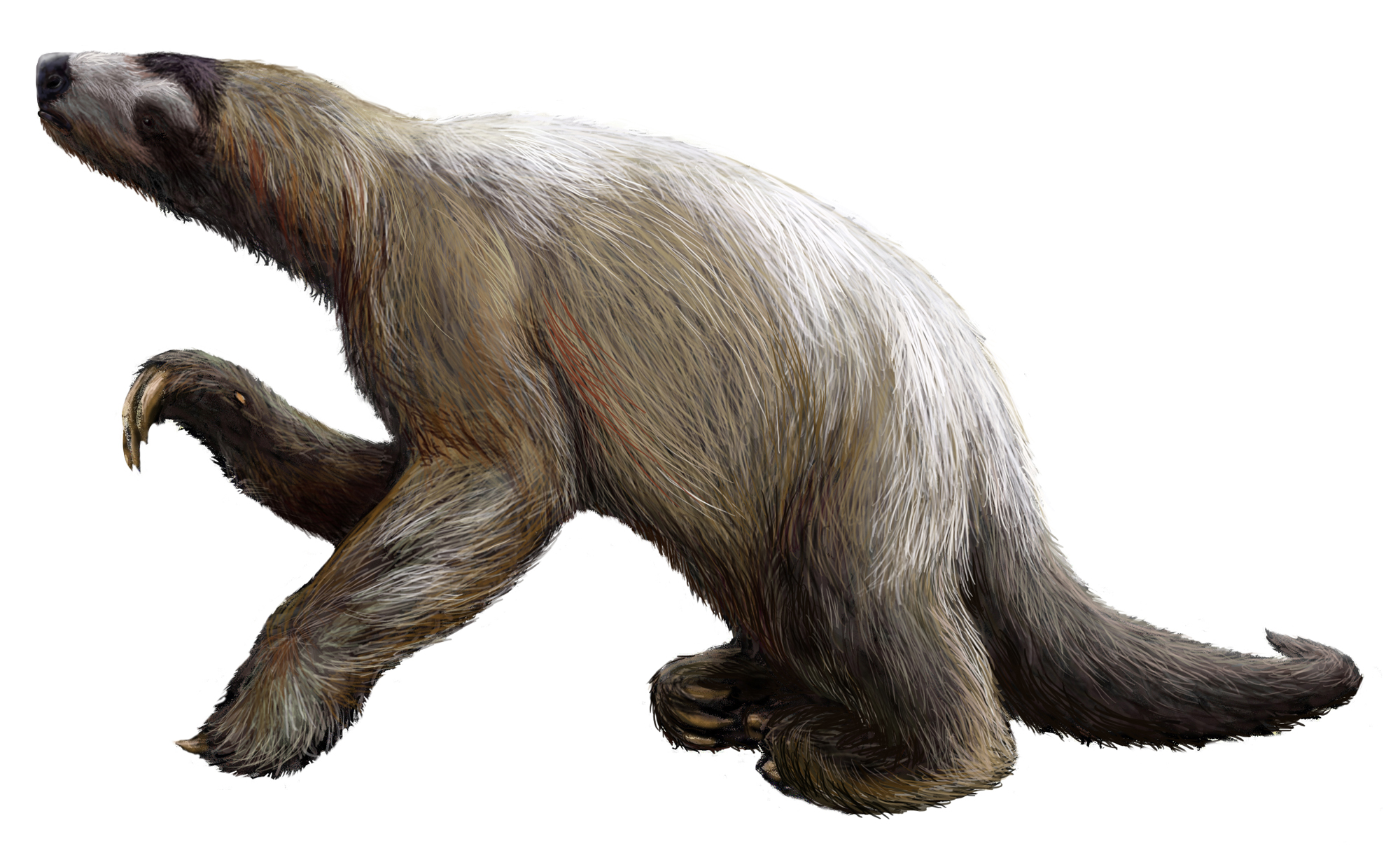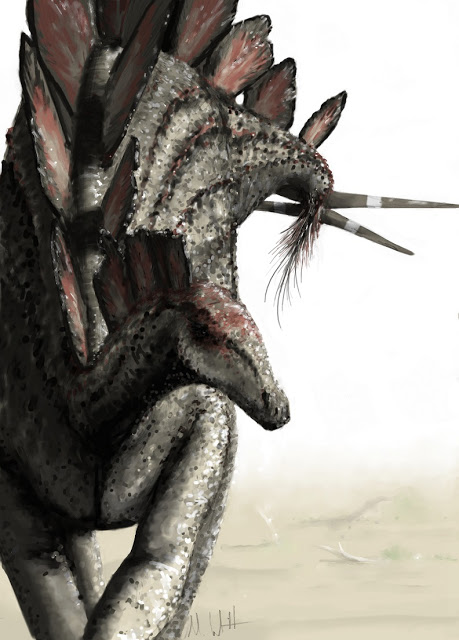 |
| Beautiful amateur artwork by yours truly. But why the fuzz? |
Xenarthra are a group of mammals exclusive to the Western Hemisphere. They include freaky animal families like Armadillos, Sloths, and Anteaters, as well as awesome extinct forms like Ground Sloths and Glyptodonts. They are bizarre on so many accounts relating to their anatomy, such as having vertebrae that articulate differently than any other mammal, their lack of tooth enamel, and don't even get me started about some of their unsavory habits, like the recently documented observations of Linnaeus's two-toed sloth drinking from human latrines (Heymann 2010). Yuck...
 |
| It suddenly seems a lot less cute after discovering about its drinking habits. I wonder how Kristen Bell reacted to that discovery... |
The thyreophoran taxa Scutellosaurus (Padian 2004), Stegosaurus (Redelstorff 2009), and numerous American ankylosaurs (Stein 2013) have all been shown to have slowed growth rates when compared to other dinosaurs. They weren't as slow as reptiles, but definitely not as fast-growing as mammals. This suggests that like xenarthrans, the Thyreophora had a metabolism slower than other dinosaur families. There is, however, the exception of Kentrosaurus, which might have had a faster growth rate (Redelstorff 2013). However, Kentrosaurus seems to have been an exception, and the majority of evidence points towards thyreophorans having lowered body temperatures like xenarthrans. Whether or not their actual body temperatures were at comparable levels to xenarthrans we don't know, but seeing as how many scientists now consider dinosaurs to be warm-blooded on the same level as modern mammals, similar thermoregulatory levels between thyreophorans and xenarthrans might be expected. I'd like to see someone try to test this idea in the future.
So, what does this all have to do with an Ankylosaurus having fuzz? Well, everything really. You see, the main argument made by people against the idea that large dinosaurs had feathers, or any type of fuzz really, is that they wouldn't need it, being large enough to be able to have a stable body temperature, as seen on modern large mammals. I have my own issues with this idea, since it assumes that protofeathers and hair are the same kind of structure (which they are not), and that dinosaurs have a similar physiology to mammals (which is unlikely). However, even assuming such ideas, we still know of large-bodied mammals that live in tropical regions which have thick, shaggy fur, and they're xenarthrans.
 |
| The Shasta Ground Sloth, a desert-dwelling sloth that was completely covered in shaggy fur. Other members of the group were the size of an Elephant and just as fluffy. |
So this would seem contrary to what people say about large mammals shedding fur at larger sizes. Why did ground sloths keep their shaggy fur in tropical environments at such large sizes while other groups of mammals of equivalent size lost their fur? Our best answer is that this was due to their lowered metabolism, which means they had a harder time holding onto body heat than other mammals. Apparently holding onto that hair was also a pretty smart move, especially since ground sloths back then were perfectly able to extend their range up into temperate regions of North America and even as far north as Alaska during the last Ice Age, while living sloths have trouble tolerating even temperate latitudes. According to McNab, this was probably due to a combination of their thick fur, as well as greater size, larger muscle mass, and a constant food supply compared to their living relatives (McNab 1985).
So assuming that ankylosaur growth rates suggest that they had lowered body temperatures like xenarthrans, might we then expect that these guys were covered in shaggy fuzz, too?
 |
| Stegosaurus with tail spines made of porcupine-like filaments. Art by Mark Witton. Looks like other scientists got the memo, or they're just slapping feathers on everything again... |
When you take all this into account, it almost makes the picture I drew kind of conservative, showing only short fuzz compared to the longer hair common on ground sloths. Perhaps I'm diving too deep into speculation right now, but I think that my idea holds some merit. What are your thoughts? As always I'd love to hear everyone's opinion on this.
Stay sharp! And make sure you check out my brand new Ankylosaur video on YouTube:
References:
Heymann, E. W., Flores Amasifuén, C., Shahuano Tello, N., Tirado Herrera, E. T. & Stojan-Dolar, M. 2010. Disgusting appetite: Two-toed sloths feeding in human latrines. Mammalian Biology doi:10.1016/j.mambio.2010.03.003
McNab, Brian K. (November 1980). "Energetics and the limits to the temperate distribution in armadillos". Journal of Mammalogy (American Society of Mammalogists) 61 (4): 606–627. doi:10.2307/1380307. JSTOR 1380307.
McNab BK (1985). Energetics, population biology, and distribution of Xenarthrans, living and extinct. In: Montgomery GG (Editor), The Evolution and Ecology of Armadillos, Sloths and Vermilinguas. Smithsonian Institution Press, Washington and London, 219-232.
Padian K, Horner JR, Ricqlès A (2004) Growth in small dinosaurs and pterosaurs: the evolution of archosaurian growth strategies. J Vert Pal 24: 555–571. doi: 10.1671/0272-4634(2004)024[0555:gisdap]2.0.co;2.
Ragna Redelstorff & P. Martin Sander (2009) Long and girdle bone histology of Stegosaurus: implications for growth and life history, Journal of Vertebrate Paleontology, 29:4, 1087-1099, DOI: 10.1671/039.029.0420
Redelstorff, R., Hübner, T. R., Chinsamy, A. and Sander, P. M. (2013), Bone Histology of the Stegosaur Kentrosaurus aethiopicus (Ornithischia: Thyreophora) from the Upper Jurassic of Tanzania. Anat Rec, 296: 933–952. doi: 10.1002/ar.22701
Stein M, Hayashi S, Sander PM (2013) Long Bone Histology and Growth Patterns in Ankylosaurs: Implications for Life History and Evolution. PLoS ONE 8(7): e68590. doi:10.1371/journal.pone.0068590
I've read a paper that suggests that the high vascularization in the large plates and spikes of ankylosaurids and polacanthids (not in nodosaurids, though) suggested a thermoregulatory function. Perhaps they stood in place of protofeather insulation? Do you have any opinions on this?
ReplyDeleteI've read about the vascularization in ankylosaur plates before, and I actually forgot about it when writing this article. Having armor that fills a thermoregulatory role may indeed help them with staying warm, even if it was only a secondary use. However, I don't think that it would affect very much of my theory here about being fuzzy for a few notable reasons.
DeleteFor one, even if they were to absorb the heat into their bodies, ankylosaurs would still need a way to hold onto the heat they absorb. The polar species especially would have to survive for up to 6 months without sunlight, and even temperate-climate species would have a lot of trouble without insulation. Polar Ground Sloths got by these problems by having shaggy fur, and by hibernating. Greg Paul suggested that because of their lowered metabolism, ankylosaurs in these areas may have hibernated, but this hasn't really been supported as far as I know.
Another thing to note about the thermoregulatory idea is that, if anything, they would probably be better at cooling the animal rather than heating it up. Having such a large surface of the body covered in osteoderms which fill this role would cause much of the body heat to be dissipated away. Crocodilians use their armor for thermoregulatory reasons, but they also spend much of their time in temperature-stable water where they don't have to worry about losing much of it, while many ankylosaurs that we know of lived in deserts and wouldn't have had that leisure.
So even if the armor did fill a thermoregulatory role, I don't think it changes much of the main idea here. Of course, as I said above, there is a lot of speculation in this post. I could very well be completely off! :)
I see. The paper said that ankylosaurs undergo extensive bone remodeling early on in life and throughout. Would the energy requirements for that process contribute to overall metabolism?
DeleteAlso, could you explain how protofeathers and hair differ? I'm sincerely interested and would like to understand better for future reference.
I don't think it should effect metabolism. Extensive bone remodeling is relatively common in reptiles and amphibians which don't have any kind of raised metabolism. They may need to feed more frequently when the remodeling is taking place in order to fuel the growth, but the speed of the growth is still very slow.
DeleteWell there are a huge number of differences between the two, and it also depends on which kind of protofeather your talking about. Assuming it's a stage 1 feather, the main difference is that protofeathers seem to be hollow filaments, while mammalian hair is made up of three distinct layers (the medulla, cortex, and cuticle) which are built atop one another. Wikipedia (while I don't advocate as a source) has some good articles on both.
Hey Tristan nice post glad to have met you at SVP. I talked with a guy at the posters about ground sloths and how the young may have been arboreal and then became more terrestrial with increasing size. On the insulation question, what we have for large ornithischians limits us to scales, tubercles etc etc. Not that you don't see scales with fuzz (like in owls feet) but the prevailing evidence points away from fuzz in most derived large bodied ornithischians/sauropods. One idea I think is worth exploring is the idea of countercurrent heat exchange, especially for polar dinosaurs. That is how swimming birds are able to keep their naked skinny lower legs in frigid waters all night long with no ill effects. Maybe some dinos circumnavigated the whole insulation dilemma entirely with efficient countercurrent heat exchange?
DeleteHey Nash! Glad to hear from you, and it was great meeting you at SVP as well.
DeleteConcerning insulation, I am aware that most of integumentary evidence points away from large ornithischians having fuzz. However, the undescribed Triceratops skin impressions may show evidence of sparse filaments, and so far all the descriptions of scales and tubercles from ornthischians and sauropods come from animals living in warm climates. It could be that polar species had different coverings than their warmer-climate kin, like how elephants are mostly hairless, but mammoths are layered.
Countercurrent heat exchange is an interesting idea, and it may be an interesting possibility. However, after reading a bit about it I noticed that it's either a) used by aquatic animals (dolphins, leatherbacks) or b) is used in restricted parts of the anatomy on terrestrial animals (feet, tail) while the rest of the body is kept warm by thick integument. I can't find an example of an animal that is terrestrial and has countercurrent heat exchange throughout the entire body system (if you know of one I'd love to know). Moreover, although countercurrent heat exchange works wonders for animals that have it, wouldn't a far more efficient way of evolving insulation just be to grow out fuzz across most of the body? Especially seeing as we now know it's part of their ancestry?
Here is an article positing that Ankylosaurus (and possibly even Stegosaurus) might have not been dinosaurs at all, but mammals! it compares the anatomy of Ankylosaurus to that of existing Xenarthrans, just like you do! Please read it and let me know what you think; if this were true, it would change everything!
ReplyDeletehttp://www.macroevolution.net/pangolins.html#.VPS3fvnF94c